Submit Chapter News to Beacon Co-Editors and OES Chapter Coordinator
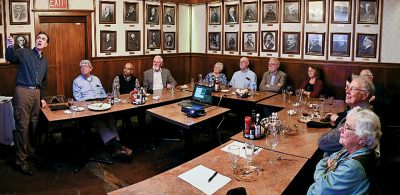
OE22 Chapter gathered for the technical talk in
“The Presidents Room.”
On May 2, 2019, members of the IEEE Providence Section and the OE22 Chapter gathered at White’s Restaurant in Westport, MA for a joint social half-hour and dinner before attentively enjoying the technical presentation “Free Wind or Bought Wind?: Shifting Power Generation at Sea over Two Centuries.” The lecturer, author John Laurence Busch, is an independent historian who focuses upon the interaction between humanity and technology, specializing in 1st and early 2nd generation steam-powered vessels. His book on the first steamship in history, entitled “STEAM COFFIN: Captain Moses Rogers and The Steamship Savannah Break the Barrier,” has received positive reviews from over two dozen periodicals and academic journals in the United States, Canada, the United Kingdom and Australia. For more information, visit www.steamcoffin.com.
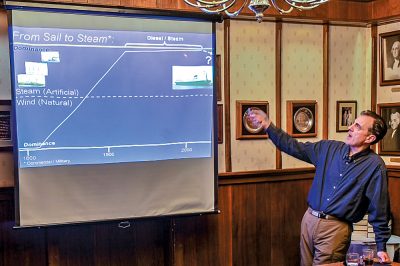
Author John Laurence Busch describing the evolution of power at sea from sail to steam over the last two centuries.
In his presentation, Mr. Busch chronicled the long evolution from natural power to artificial power at sea, breaking down the development from both a “steamboat” and “steamship” perspective.
At the beginning of the 19th century, the human race remained—practically speaking—in the same place it had been for millennia. Humans were beholden to the omnipotence of Nature, meaning the only way to move themselves from one place to another was by natural means. On land, this meant foot, hoof, or wheel, all of which were powered by animals; on water, it was either human-driven paddles or wind-driven sails. There was little reason to believe human locomotion would ever be any different.
Then, in 1807, an American named Robert Fulton built and ran the first commercially successful “steamboat” in history. In so doing, Fulton achieved something epically important: he proved that humans could create an artificial power to alter where they were and when they were there to practical effect. No other invention had achieved such a thing, and accordingly, steamboats may be considered the first “high technology” in history.
But the transition from sail energy to steam energy was not immediate, or easy. Nor was the transition from steamboats running on rivers, lakes and bays to steamships capable of making trans-ocean voyages.
The author then analyzed modern-day efforts to re-introduce various forms of natural power to modern, artificially-powered commercial vessels, and the rationale for doing so. This included an analysis of the types of fuel used to power the “new mode of transport,” as well as efforts by the “old mode of transport” (i.e., sail) to compete, which led to a very long battle for supremacy at sea.
Technologies touched on included recent design proposals such as high profile sail-like hull shapes, and arrays of deck-mounted sail-like solar panel arrays. One particularly promising technology, which has seen a recent revival, is the Flettner rotor. A Flettner rotor is a smooth cylinder with disc end plates which is spun along its long axis and, as air passes at right angles across it, the Magnus effect causes an aerodynamic force to be generated in the direction perpendicular to both the long axis and the direction of airflow. First introduced on an experimental rotor ship in 1922, this technology is again being considered as a means to reduce both fuel costs and carbon emissions.
Finally, the possibility that other high technologies will revert to some or a greater share of natural power generation was explored, and how studying the initial development of these inventions might help show the way forward.
Singapore Chapter—A Workshop on Autonomous Marine Systems
Reported by Bharath Kalyan, Hari Vishnu, Venugopalan Pallayil & Ahmed Mahmood
The IEEE OES Singapore chapter organized its third annual workshop on Autonomous Marine Systems on 11 March, 2019, at the Singapore Polytechnic, following the 7th edition of the Singapore AUV Challenge (SAUVC) event. The workshop idea was started in 2017 with an objective of complementing the hands-on experience that the students had gathered through the competition, with further insights from experts in the field. The workshop was aimed at motivating the students to continue to pursue the field of autonomous marine technology and enhance their knowledge through a sharing and learning session. This year’s guest speakers included a good mix of experts from land and marine robotics and also representation from academia, industry, research institutions as well as student competition organisers and participants. This event also facilitated excellent networking amongst the AUV experts and the attendees, which included both student team members and external attendees. The talks were followed by a panel discussion. The focus of the panel discussion revolved around questions posed by the student attendees, which was collated via an online poll taken prior to the workshop.
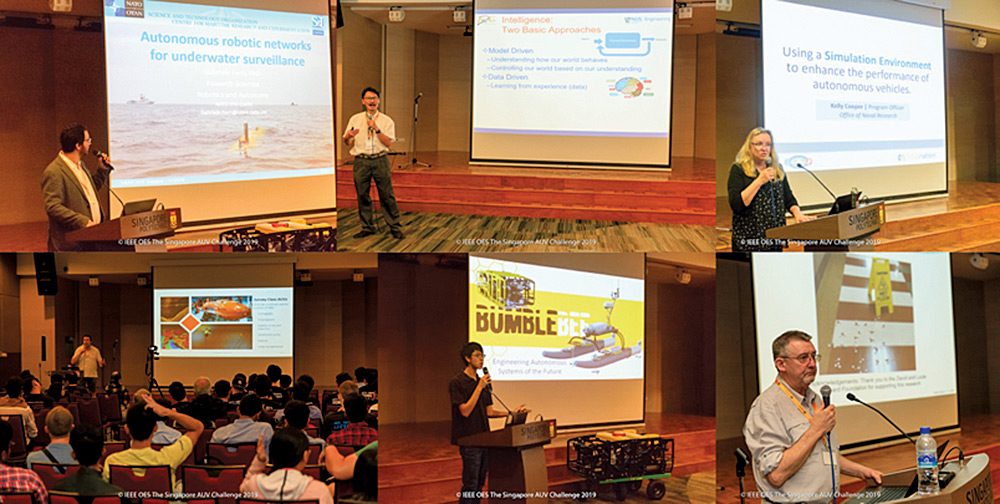
The guest speakers included Dr. Gabriele Ferri, Assoc Prof Marcelo H. Ang, Jr, Ms. Kelly Cooper, Mr. Richard Mills, Mr. William J. Kirkwood and student Liu Ren Jie. Gabriele Ferri is a Research Scientist at the NATO’s Centre for Maritime Research & Experimentation (CMRE). He spoke on autonomous robotics networks for underwater surveillance. In this talk, he compared the performance of autonomous vehicles for surveillance applications when operated in a networked configuration as compared to a single AUV configuration. He also discussed the potential and challenges of such a configuration. Marcelo H. Ang, Jr is an Associate Professor in the Department of Mechanical Engineering of National University of Singapore, delivered the second talk. He spoke on the impact of robotics in our daily lives and delved on the emerging applications in human robot interactions in unstructured environments. He also touched up on the state-of-the-art developments in sensing and intelligence to accelerate robotics revolution. Kelly Cooper is a Program Officer at the Office of Naval Research (ONR). She has been responsible for initiating a variety of student robotics competitions for the U.S. Navy, including the Maritime RobotX Challenge, RoboBoat and SeaPerch. In the post-lunch session, Kelly spoke about using a simulation environment (virtual competition) to enhance the performance of autonomous vehicles. Her talk was also an introduction to the Virtual RobotX competition, a new initiative by ONR. Richard Mills, who is the Director of Marine Robotics Sales with Kongsberg Maritime, spoke about improving productivity in deep water AUV surveys. He also discussed various sensing technologies that have gone into the HUGIN AUV including synthetic aperture sonar, multibeam echo-sounder, sub-bottom profiler, camera, laser, magnetometer and methane sensors. William J. Kirkwood is a senior R&D Engineer at Monterey Bay Aquarium Research Institute (MBARI). He spoke about plastics in the food web, and how it was a problem that required future technology solutions. Bill discussed about microplastics and their impact on our oceans and in-turn, on humans. His talk also focused on advanced instrumentation and robotics that are able to identify these plastics and trace them to their source. Finally, we had one talk from a student, Liu Ren Jie, a 4th year Electrical Engineering student from the National University of Singapore and also is the technical lead of the Bumblebee team. He spoke passionately about team Bumblebee and how they managed the challenges of sustaining and growing a student-run team and covered topics ranging from knowledge management to competition preparations. The video recordings of these talks can be viewed at the following link:
https://www.youtube.com/user/ARLTMSINUSChannel/videos. All the talks were well-received by the attendees.
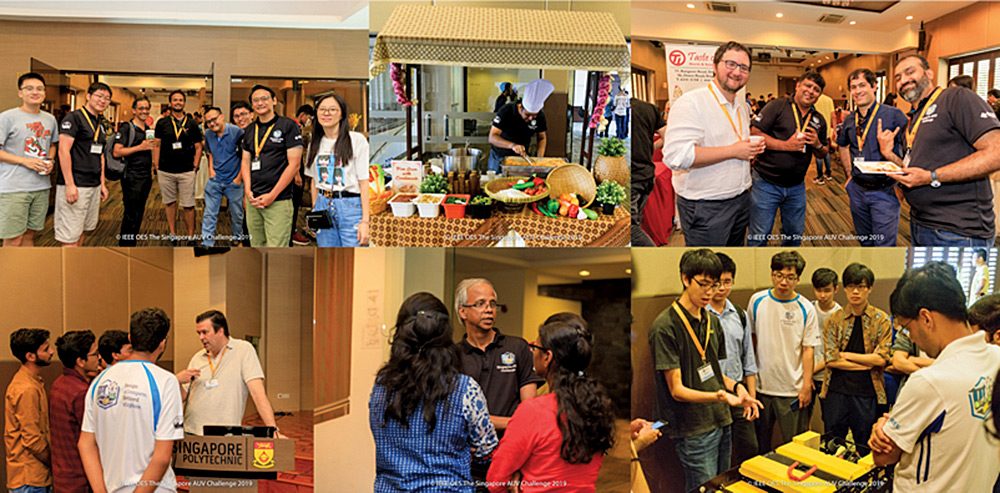
In the afternoon session of the workshop, a panel discussion by the experts on autonomous marine systems and competitions and careers in underwater technologies was organized. The questions taken up for discussion by the panelists, were collected via a student participant’s poll, the Pigeonhole App. The top 10 questions polled by the audience via an online poll were taken up at the discussion. The questions that were posed to the panel were:
- What career opportunities are available in underwater robotics?
- Tips to “debug” underwater robots during development?
- What role does ROS play in the development of underwater robotics?
- Any tips on how to build low-cost underwater robots?
- How to tackle challenges like Localization, navigation & communications?
- How does AUV research in Asia compare to Europe and North America?
- How can we better promote AUV activities in secondary schools?
- How can we harvest energy from the ocean for use by underwater robots?
- How to use underwater tech to solve ocean pollution problems?
- What is the role of swarm technology in underwater robotics?
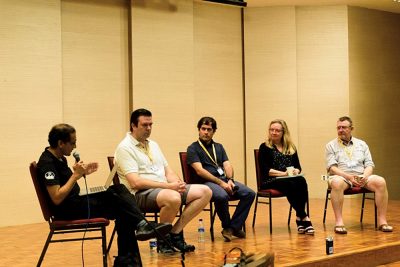
The panel was moderated by Mandar Chitre, Associate Professor at National University of Singapore. Fausto Ferreira, a Research Scientist from at the NATO’s Centre for Maritime Research & Experimentation (CMRE) joined as a panelist along with William Kirkwood, Richard Mills and Kelly Cooper. All the questions posed via the poll were pertinent to student involvement in AUV technologies and competitions. They included queries on the future of AUVs, the benefit and career opportunities for students in this field, how to tackle some commonly faced issues in constructing AUVs and questions on real-world applications of AUVs. The questions saw some very animated involvement from the panel members, who all chipped in to give a well-rounded take on the students’ queries. Overall, the workshop turned out to be a useful learning experience for all the participants.
Apart from this workshop on the side-lines of SAUVC (the report is in this issue), we had two public engagement sessions which were conducted at Singapore Polytechnic on March 9th, 2019:
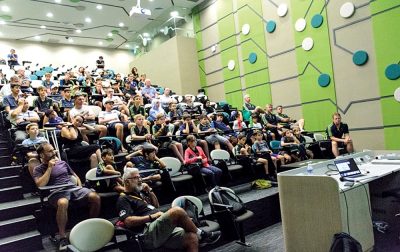
Singapore Robot Operating System (ROS) Meetup organized a session on practitioner’s guide to autonomous vehicle development. Dr. Benjamin Ma discussed about an on-going self-driving car project and provided an overview of future of autonomous vehicles.
The SAUVC LOC organized a tutorial session on “Introduction to underwater robotics.” The tutorial was led by Rajat Mishra, a graduate research student with National University of Singapore. At this session, we had a large representation from ANZA scouts with students in the age group of 8–17 years. This event was very well-received and we are planning on expanding the public engagement exercise for the next edition of SAUVC.
These workshops were very beneficial for the students, specifically for the teams who participated in the SAUVC event. This was evident from the excellent feedback we obtained through a survey. We propose to continue the organization of similar workshops alongside future SAUVC events. We would like to acknowledge our speakers for their inspirational talks and supporting this event.
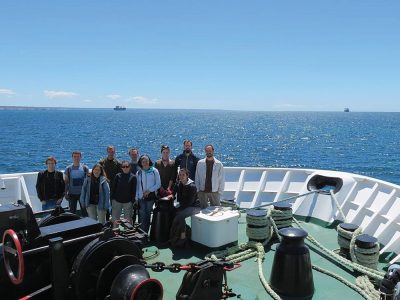
course at the BIP Víctor Angelescu.
Argentina Chapter—Post-degree Course: “Introduction to Underwater Acoustics”
Reported by Gerardo Acosta
During the days 26 to 30 of November 2018, the post-degree course “Introduction to Underwater Acoustics” was carried out at the city of Puerto Madryn, Chubut, Argentina. This course was given at the CENPAT (Centro Nacional Patagónico). Daniel Rodriguez, PhD (UDE, Spain) and Noela Sánchez Carnero, PhD (CESIMAR-CENPAT, Argentina) were the professors in charge. The course covered the theoretical principles of sound propagation in underwater environments, SONAR fundamentals and the working principles of the most common acoustic equipment for hydrographic, bottom and sub-bottom structures and fishery studies. A practical session on gathering and post-processing of Single Beam and Side Scan SONAR data was also carried out. The course concluded with a guided visit to the BIP Víctor Angelescu (INIDEP) and the oceanographic vessel ARA Austral (Q-21) moored at the local Luis Piedrabuena dock. Several professionals of diverse disciplines: physics, biologists, a geologist and engineer members of different institutions, participated in the course. Among these institutions were: INIDEP, Argentinean Antarctic Institute, CENPAT, INTELYMEC (FIO-UNCPBA) and other Nationals Universities. The IEEE OES sponsored some of the attendees.
Workshop: “Broadband Acoustics Advances and SIMRAD EK-80 Scientific Sound Applications”
Reported by Gerardo Acosta

During the past March 6 to 9 of 2019, the Workshop “Broadband Acoustics Advances and SIMRAD EK-80 scientific sound applications” was carried out at INIDEP facilities in the city of Mar del Plata, Buenos Aires, Argentina, with the Hydro acoustic Cabinet Chief Eng. Adrián Madirolas as instructor. The workshop covered the theoretical and practical aspects of the broadband acoustics principles. Practical sessions of EK-80 data processing in classroom and EK-80 Split Beam transducer calibration at the oceanographic vessel ARA Austral (Q-21) were carried out.
People with different backgrounds, like physics, biologists, Argentinian Navy personnel, officers and sub-officers and engineer members of different institutions (INIDEP, Argentinean Antarctic Institute, Argentinian Navy Hydrographic Service, CENPAT, CADIC, UNIDEF, INTELYMEC (FIO-UNCPBA) and other Nationals Universities) attended the workshop that was sponsored by the local IEEE OES Chapter.
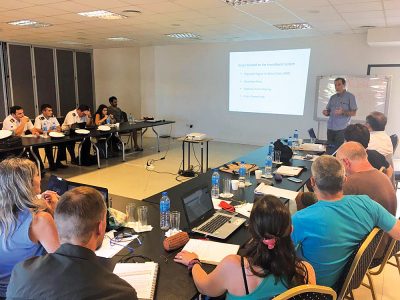
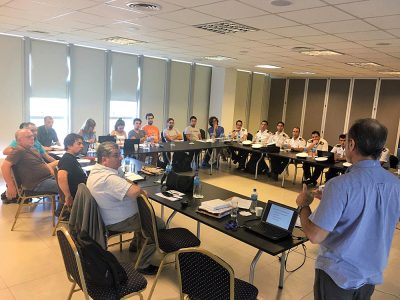
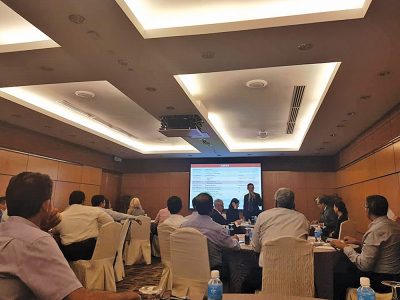
Malaysia Chapter
Reported by Khalid Isa
The first OTC Asia 2020 technical programme committee organisational meeting was held on 19 Feb 2019 at the Kuala Lumpur Convention Centre. IEEE OES was invited as the Programme Subcommittee. Khalid Isa, as the Chair of IEEE OES Malaysia Chapter, attended this meeting as the representative of IEEE OES. The agenda of the meeting is to discuss the programme structure and workflow. OTC Asia 2020 to be held 24–27 March 2020 at the Kuala Lumpur Convention Centre in Malaysia.
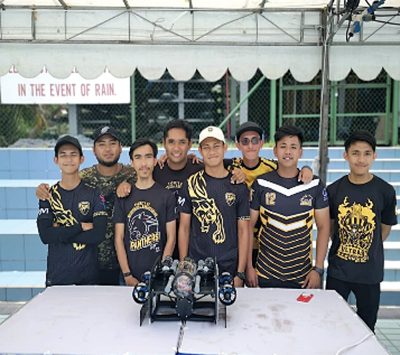
Singapore Autonomous Underwater Vehicle Challenge (SAUVC 2019)
Reported by Mohd Shahrieel Mohd Aras
IEEE OES Malaysia Chapter has sent 4 teams. Universiti Teknikal Malaysia Melaka (UTeM) Team are Panther, Tuah and Noah’s Arc are represented by students from the Faculty of Electrical Engineering, Faculty of Mechanical Engineering and Faculty of Technology Engineering. Dr. Mohd Shahrieel Mohd Aras and Dr. Ahmad Anas Yusof is an Advisor for this team and also Vice Chair and an executive committee of the IEEE OES Malaysia Chapter. From International Islamic University Malaysia (UIAM), the Roboteam is lead by Dr. Zulkifli bin Zainal Abidin. Having completed the first task in the final round, the Panthers team has been ranked 4th place and IIUM Roboteam 5th place from more than 60 register team from Russia, Japan, Singapore, Hong Kong, Thailand, Sri Lanka, China, India, Pakistan, Bangladesh, Indonesia, and Malaysia.
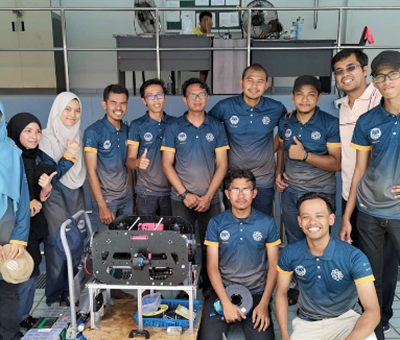
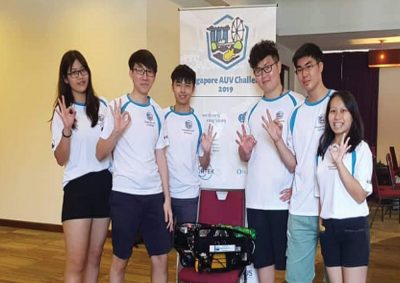
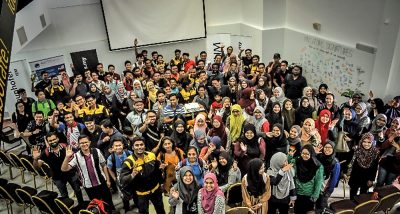
Industrial Lecture on RADAR Level Measurement Technology
Reported by Herdawatie Abdul Kadir and Khalid Isa
This event was held at the Innovation Lab. Universiti Tun Hussein Onn Malaysia (UTHM). The invited speaker, Ir. Shah Rizal Dahlan from Petronas, gave a presentation on RADAR level measurement Technology. He provided both fundamental studies on the development and application of Radar as used for measuring level. We benefited in his availability in Petronas, Malaysia, due to his position as Custodian Engineer and Group Technical Authority for instrument and controls in PETRONAS. This talk was conducted on February 24, 2019, and attended by 15 IEEE members and 180 guests.
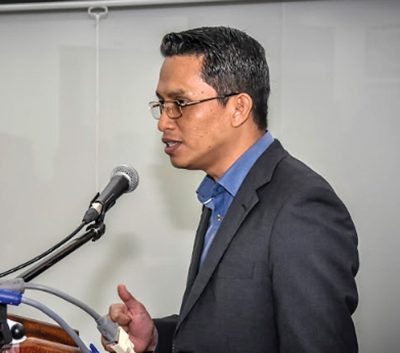
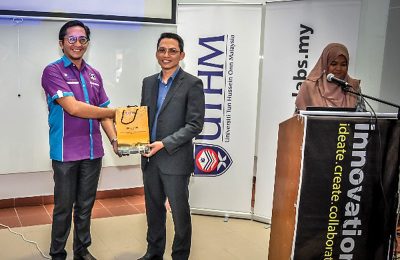
OES Malaysia Chapter) and Shah Rizal.

application using ROS.
Robotics Operating System (ROS) Workshop
Reported by Herdawatie Abdul Kadir
On 3rd March 2019, The IEEE OES Malaysia Chapter organized a technical workshop ROS. The event took place at Innovation Lab, Universiti Tun Hussein Onn Malaysia (UTHM), Johor, Malaysia. The workshop was conducted by Dr. Abu Ubaidah Shamsuddin from UTHM. The purpose of the workshop was to share the fundamental behind the open source robotics framework using ROS Kinetic Kame is primarily targeted at Ubuntu. The workshop was attended by participants from various agencies, including representatives from the other university undergraduate and postgraduate students. The participants were divided into several groups that follow hands-on learning and in-depth explanation.



 Suleman Mazhar has been working as a professor in Information & Communication Engineering at Harbin Engineering University (China) since July 2019. He did PhD from Tokyo University (Japan) and postdoctorate from Georgetown University (Washington DC, USA). He had BS-CS from FAST-NUCES (Lahore) and MS from GIK Institute (Pakistan). He is TYSP young scientist fellow (Ministry of Science & Technology China) and have won several research grants from international organizations such as DAAD (Germany), ICIMOD (Nepal), NRPU (Higher Education Commission Pakistan), WWF (Worldwide Fund for Nature) Pakistan. His research focus is deep learning and signal processing applications for environmental monitoring, with particular focus on underwater acoustics, and marine mammal conservation. He is a reviewer for professional journals such as Journal of Acoustical Society (America), IEEE Journal of Oceanic Engineering, IEEE Sensors Journal, Applied Acoustics, IEEE Transactions on Intelligent Transportation Systems.
Suleman Mazhar has been working as a professor in Information & Communication Engineering at Harbin Engineering University (China) since July 2019. He did PhD from Tokyo University (Japan) and postdoctorate from Georgetown University (Washington DC, USA). He had BS-CS from FAST-NUCES (Lahore) and MS from GIK Institute (Pakistan). He is TYSP young scientist fellow (Ministry of Science & Technology China) and have won several research grants from international organizations such as DAAD (Germany), ICIMOD (Nepal), NRPU (Higher Education Commission Pakistan), WWF (Worldwide Fund for Nature) Pakistan. His research focus is deep learning and signal processing applications for environmental monitoring, with particular focus on underwater acoustics, and marine mammal conservation. He is a reviewer for professional journals such as Journal of Acoustical Society (America), IEEE Journal of Oceanic Engineering, IEEE Sensors Journal, Applied Acoustics, IEEE Transactions on Intelligent Transportation Systems. Peng Ren is a full professor with the College of Oceanography and Space Informatics, China University of Petroleum (East China). He is the director of Qingdao International Research Center for Intelligent Forecast and Detection of Oceanic Catastrophes. He received the K. M. Scott Prize from the University of York, the Natural Science award (first rank) from China Institute of Electronics, and the Eduardo Caianiello Best Student Paper Award from 18th International Conference on Image Analysis and Processing as one co-author. He has served as an associate editor of IEEE Transactions on Geoscience and Remote Sensing.
Peng Ren is a full professor with the College of Oceanography and Space Informatics, China University of Petroleum (East China). He is the director of Qingdao International Research Center for Intelligent Forecast and Detection of Oceanic Catastrophes. He received the K. M. Scott Prize from the University of York, the Natural Science award (first rank) from China Institute of Electronics, and the Eduardo Caianiello Best Student Paper Award from 18th International Conference on Image Analysis and Processing as one co-author. He has served as an associate editor of IEEE Transactions on Geoscience and Remote Sensing. Mohd Rizal Arshad is a full professor at the School of Electrical and Electronic Engineering at Universiti Sains Malaysia (USM), Malaysia, where he specializes in ocean robotics technology and intelligent system. He received his B.Eng. in Medical Electronics & Instrumentation and PhD in Electronic Engineering from University of Liverpool, UK in 1994 and 1999, respectively. He completed his MSc. in Electronic Control Engineering from the University of Salford, UK in Dec 1995. He has supervised many postgraduate students and published extensively in local and international publications. He is a senior member of the IEEE, and was awarded IEEE OES Presidential Award in 2019.
Mohd Rizal Arshad is a full professor at the School of Electrical and Electronic Engineering at Universiti Sains Malaysia (USM), Malaysia, where he specializes in ocean robotics technology and intelligent system. He received his B.Eng. in Medical Electronics & Instrumentation and PhD in Electronic Engineering from University of Liverpool, UK in 1994 and 1999, respectively. He completed his MSc. in Electronic Control Engineering from the University of Salford, UK in Dec 1995. He has supervised many postgraduate students and published extensively in local and international publications. He is a senior member of the IEEE, and was awarded IEEE OES Presidential Award in 2019. Itzik Klein is an Assistant Professor, heading the Autonomous Navigation and Sensor Fusion Lab, at the Charney School of Marine Sciences, Hatter Department of Marine Technologies, University of Haifa. He is an IEEE Senior Member and a member of the IEEE Journal of Indoor and Seamless Positioning and Navigation (J-ISPIN) Editorial Board. Prior to joining the University of Haifa, he worked at leading companies in Israel on navigation topics for more than 15 years. He has a wide range of experience in navigation systems and sensor fusion from both industry and academic perspectives. His research interests lie in the intersection of artificial intelligence with inertial sensing, sensor fusion, and autonomous underwater vehicles.
Itzik Klein is an Assistant Professor, heading the Autonomous Navigation and Sensor Fusion Lab, at the Charney School of Marine Sciences, Hatter Department of Marine Technologies, University of Haifa. He is an IEEE Senior Member and a member of the IEEE Journal of Indoor and Seamless Positioning and Navigation (J-ISPIN) Editorial Board. Prior to joining the University of Haifa, he worked at leading companies in Israel on navigation topics for more than 15 years. He has a wide range of experience in navigation systems and sensor fusion from both industry and academic perspectives. His research interests lie in the intersection of artificial intelligence with inertial sensing, sensor fusion, and autonomous underwater vehicles. John R. Potter (IEEE M’94, SM’02, F’18) graduated in the previous century with a joint honours Mathematics and Physics Degree from Bristol and a PhD. in Glaciology and Oceanography from Cambridge, UK studying Antarctic ice mass balance, where he spent four consecutive summers. This work helped underscore the non-linear fragility of polar ice to climate change and led to him receiving the Polar Medal from Queen Elizabeth II in 1988.
John R. Potter (IEEE M’94, SM’02, F’18) graduated in the previous century with a joint honours Mathematics and Physics Degree from Bristol and a PhD. in Glaciology and Oceanography from Cambridge, UK studying Antarctic ice mass balance, where he spent four consecutive summers. This work helped underscore the non-linear fragility of polar ice to climate change and led to him receiving the Polar Medal from Queen Elizabeth II in 1988. Nick is a Visiting Fellow at the UK National Oceanographic Center, Southampton His nomination was endorsed by the Underwater Acoustics Technology Committee. He had worked as a Research Associate and Lecturer at University of Birmingham and has been working as a Research Scientist at the Applied Research Laboratory, University of Texas, Austin. He has also served as a Program Officer at the Office of Naval Research Global. He is a senior member of IEEE (OES) and a Fellow of Acoustical Society of America (ASA). Nick has also been serving as Assoc. Editor for IEEE JoE and JASA. He is widely acknowledged for his expertise are seabed acoustics, parametric array modeling, sonar beamformer, underwater signal processing.
Nick is a Visiting Fellow at the UK National Oceanographic Center, Southampton His nomination was endorsed by the Underwater Acoustics Technology Committee. He had worked as a Research Associate and Lecturer at University of Birmingham and has been working as a Research Scientist at the Applied Research Laboratory, University of Texas, Austin. He has also served as a Program Officer at the Office of Naval Research Global. He is a senior member of IEEE (OES) and a Fellow of Acoustical Society of America (ASA). Nick has also been serving as Assoc. Editor for IEEE JoE and JASA. He is widely acknowledged for his expertise are seabed acoustics, parametric array modeling, sonar beamformer, underwater signal processing. Maurizio Migliaccio (M’91-SM’00-F’17) is Full professor of Electromagnetics at Università di Napoli Parthenope (Italy) and was Affiliated Full Professor at NOVA Southeastern University, Fort Lauderdale, FL (USA). He has been teaching Microwave Remote Sensing since 1994. He was visiting scientist at Deutsche Forschungsanstalt fur Lüft und Raumfahrt (DLR), Oberpfaffenhofen, Germany. He was member of the Italian Space Agency (ASI) scientific committee. He was member of the ASI CosmoSkyMed second generation panel. He was e-geos AdCom member. He was Italian delegate of the ESA PB-EO board. He was Member of South Africa Expert Review Panel for Space Exploration. He serves as reviewer for the UE, Italian Research Ministry (MIUR), NCST, Kazakhstan and Hong Kong Research board. He lectured in USA, Canada, Brazil, China, Hong Kong, Germany, Spain, Czech Republic, Switzerland and Italy. He was Italian delegate at UE COST SMOS Mode Action. He is listed in the Italian Top Scientists. He is an IEEE Trans. Geoscience and Remote Sensing AE, International Journal of Remote Sensing AE, and was IEEE Journal of Oceanic Engineering AE Special Issue on Radar for Marine and Maritime Remote Sensing, IEEE JSTARS AE of the Special Issue on CosmoSKyMed, Member of the Indian Journal of Radio & Space Physics Editorial board. His main current scientific interests cover SAR sea oil slick and man-made target monitoring, remote sensing for marine and coastal applications, remote sensing for agriculture monitoring, polarimetry, inverse problems for resolution enhancement, reverberating chambers. He published about 160 peer-reviewed journal papers on remote sensing and applied electromagnetics.
Maurizio Migliaccio (M’91-SM’00-F’17) is Full professor of Electromagnetics at Università di Napoli Parthenope (Italy) and was Affiliated Full Professor at NOVA Southeastern University, Fort Lauderdale, FL (USA). He has been teaching Microwave Remote Sensing since 1994. He was visiting scientist at Deutsche Forschungsanstalt fur Lüft und Raumfahrt (DLR), Oberpfaffenhofen, Germany. He was member of the Italian Space Agency (ASI) scientific committee. He was member of the ASI CosmoSkyMed second generation panel. He was e-geos AdCom member. He was Italian delegate of the ESA PB-EO board. He was Member of South Africa Expert Review Panel for Space Exploration. He serves as reviewer for the UE, Italian Research Ministry (MIUR), NCST, Kazakhstan and Hong Kong Research board. He lectured in USA, Canada, Brazil, China, Hong Kong, Germany, Spain, Czech Republic, Switzerland and Italy. He was Italian delegate at UE COST SMOS Mode Action. He is listed in the Italian Top Scientists. He is an IEEE Trans. Geoscience and Remote Sensing AE, International Journal of Remote Sensing AE, and was IEEE Journal of Oceanic Engineering AE Special Issue on Radar for Marine and Maritime Remote Sensing, IEEE JSTARS AE of the Special Issue on CosmoSKyMed, Member of the Indian Journal of Radio & Space Physics Editorial board. His main current scientific interests cover SAR sea oil slick and man-made target monitoring, remote sensing for marine and coastal applications, remote sensing for agriculture monitoring, polarimetry, inverse problems for resolution enhancement, reverberating chambers. He published about 160 peer-reviewed journal papers on remote sensing and applied electromagnetics. He has developed various types of Autonomous Underwater Vehicles (AUVs) and related application technologies including navigation methods, a new sensing method using a chemical sensor, precise seafloor mapping methods, a precise seabed positioning system with a resolution of a few centimeters, a new sensing system of the thickness of cobalt-rich crust; and more. He has shown, by using these technologies that AUVs are practicable and valuable tools for deep-sea exploration.
He has developed various types of Autonomous Underwater Vehicles (AUVs) and related application technologies including navigation methods, a new sensing method using a chemical sensor, precise seafloor mapping methods, a precise seabed positioning system with a resolution of a few centimeters, a new sensing system of the thickness of cobalt-rich crust; and more. He has shown, by using these technologies that AUVs are practicable and valuable tools for deep-sea exploration. Donna Kocak has had an outstanding career in defense and scientific projects developing and applying solutions in subsea optics, imaging and robotics. She graduated with an M.Sc in Computer Science in 1997 from the University of Central Florida; an MBA in 2008 from the University of Florida; and M.Sc in Industrial Engineering in 2011 from the University of Central Florida. She is currently a Senior Scientist, Advanced Concepts Engineering, and Fellow at the Harris Corporation in Melbourne, Florida, where she has developed novel optical imaging and communication solutions for under-sea defense and scientific projects. Prior to 2008 Donna Kocak was Founder and President of Green Sky Imaging, LLC (GSI) who developed laser/video photogrammetry software for underwater inspection and survey. Her earlier career positions were with Naval Training Systems Center, Florida; Harbor Branch Oceanographic Institution, Florida; eMerge Interactive; and the Advanced Technologies Group in Florida.
Donna Kocak has had an outstanding career in defense and scientific projects developing and applying solutions in subsea optics, imaging and robotics. She graduated with an M.Sc in Computer Science in 1997 from the University of Central Florida; an MBA in 2008 from the University of Florida; and M.Sc in Industrial Engineering in 2011 from the University of Central Florida. She is currently a Senior Scientist, Advanced Concepts Engineering, and Fellow at the Harris Corporation in Melbourne, Florida, where she has developed novel optical imaging and communication solutions for under-sea defense and scientific projects. Prior to 2008 Donna Kocak was Founder and President of Green Sky Imaging, LLC (GSI) who developed laser/video photogrammetry software for underwater inspection and survey. Her earlier career positions were with Naval Training Systems Center, Florida; Harbor Branch Oceanographic Institution, Florida; eMerge Interactive; and the Advanced Technologies Group in Florida. John Potter has a Joint Honours degree in Mathematics and Physics from Bristol University in the UK and a PhD in Glaciology and Oceanography from the University of Cambridge on research in the Antarctic, for which he was awarded the Polar Medal in 1988. John has worked on polar oceanography, underwater acoustics, ambient noise (including imaging), marine mammals, communications, IoUT, autonomous vehicles and strategic development. He has 40 years’ international experience working at the British Antarctic Survey in the UK, NATO in Italy, SIO in California, NUS in Singapore and most recently at NTNU in Norway. John is a Fellow of the IEEE and MTS, an Associate Editor for the IEEE Journal of Oceanic Engineering, IEEE OES Distinguished Lecturer, PADI Master Scuba Diver Trainer & an International Fellow of the Explorer’s Club.
John Potter has a Joint Honours degree in Mathematics and Physics from Bristol University in the UK and a PhD in Glaciology and Oceanography from the University of Cambridge on research in the Antarctic, for which he was awarded the Polar Medal in 1988. John has worked on polar oceanography, underwater acoustics, ambient noise (including imaging), marine mammals, communications, IoUT, autonomous vehicles and strategic development. He has 40 years’ international experience working at the British Antarctic Survey in the UK, NATO in Italy, SIO in California, NUS in Singapore and most recently at NTNU in Norway. John is a Fellow of the IEEE and MTS, an Associate Editor for the IEEE Journal of Oceanic Engineering, IEEE OES Distinguished Lecturer, PADI Master Scuba Diver Trainer & an International Fellow of the Explorer’s Club. Dr. James V. Candy is the Chief Scientist for Engineering and former Director of the Center for Advanced Signal & Image Sciences at the University of California, Lawrence Livermore National Laboratory. Dr. Candy received a commission in the USAF in 1967 and was a Systems Engineer/Test Director from 1967 to 1971. He has been a Researcher at the Lawrence Livermore National Laboratory since 1976 holding various positions including that of Project Engineer for Signal Processing and Thrust Area Leader for Signal and Control Engineering. Educationally, he received his B.S.E.E. degree from the University of Cincinnati and his M.S.E. and Ph.D. degrees in Electrical Engineering from the University of Florida, Gainesville. He is a registered Control System Engineer in the state of California. He has been an Adjunct Professor at San Francisco State University, University of Santa Clara, and UC Berkeley, Extension teaching graduate courses in signal and image processing. He is an Adjunct Full-Professor at the University of California, Santa Barbara. Dr. Candy is a Fellow of the IEEE and a Fellow of the Acoustical Society of America (ASA) and elected as a Life Member (Fellow) at the University of Cambridge (Clare Hall College). He is a member of Eta Kappa Nu and Phi Kappa Phi honorary societies. He was elected as a Distinguished Alumnus by the University of Cincinnati. Dr. Candy received the IEEE Distinguished Technical Achievement Award for the “development of model-based signal processing in ocean acoustics.” Dr. Candy was selected as a IEEE Distinguished Lecturer for oceanic signal processing as well as presenting an IEEE tutorial on advanced signal processing available through their video website courses. He was nominated for the prestigious Edward Teller Fellowship at Lawrence Livermore National Laboratory. Dr. Candy was awarded the Interdisciplinary Helmholtz-Rayleigh Silver Medal in Signal Processing/Underwater Acoustics by the Acoustical Society of America for his technical contributions. He has published over 225 journal articles, book chapters, and technical reports as well as written three texts in signal processing, “Signal Processing: the Model-Based Approach,” (McGraw-Hill, 1986), “Signal Processing: the Modern Approach,” (McGraw-Hill, 1988), “Model-Based Signal Processing,” (Wiley/IEEE Press, 2006) and “Bayesian Signal Processing: Classical, Modern and Particle Filtering” (Wiley/IEEE Press, 2009). He was the General Chairman of the inaugural 2006 IEEE Nonlinear Statistical Signal Processing Workshop held at the Corpus Christi College, University of Cambridge. He has presented a variety of short courses and tutorials sponsored by the IEEE and ASA in Applied Signal Processing, Spectral Estimation, Advanced Digital Signal Processing, Applied Model-Based Signal Processing, Applied Acoustical Signal Processing, Model-Based Ocean Acoustic Signal Processing and Bayesian Signal Processing for IEEE Oceanic Engineering Society/ASA. He has also presented short courses in Applied Model-Based Signal Processing for the SPIE Optical Society. He is currently the IEEE Chair of the Technical Committee on “Sonar Signal and Image Processing” and was the Chair of the ASA Technical Committee on “Signal Processing in Acoustics” as well as being an Associate Editor for Signal Processing of ASA (on-line JASAXL). He was recently nominated for the Vice Presidency of the ASA and elected as a member of the Administrative Committee of IEEE OES. His research interests include Bayesian estimation, identification, spatial estimation, signal and image processing, array signal processing, nonlinear signal processing, tomography, sonar/radar processing and biomedical applications.
Dr. James V. Candy is the Chief Scientist for Engineering and former Director of the Center for Advanced Signal & Image Sciences at the University of California, Lawrence Livermore National Laboratory. Dr. Candy received a commission in the USAF in 1967 and was a Systems Engineer/Test Director from 1967 to 1971. He has been a Researcher at the Lawrence Livermore National Laboratory since 1976 holding various positions including that of Project Engineer for Signal Processing and Thrust Area Leader for Signal and Control Engineering. Educationally, he received his B.S.E.E. degree from the University of Cincinnati and his M.S.E. and Ph.D. degrees in Electrical Engineering from the University of Florida, Gainesville. He is a registered Control System Engineer in the state of California. He has been an Adjunct Professor at San Francisco State University, University of Santa Clara, and UC Berkeley, Extension teaching graduate courses in signal and image processing. He is an Adjunct Full-Professor at the University of California, Santa Barbara. Dr. Candy is a Fellow of the IEEE and a Fellow of the Acoustical Society of America (ASA) and elected as a Life Member (Fellow) at the University of Cambridge (Clare Hall College). He is a member of Eta Kappa Nu and Phi Kappa Phi honorary societies. He was elected as a Distinguished Alumnus by the University of Cincinnati. Dr. Candy received the IEEE Distinguished Technical Achievement Award for the “development of model-based signal processing in ocean acoustics.” Dr. Candy was selected as a IEEE Distinguished Lecturer for oceanic signal processing as well as presenting an IEEE tutorial on advanced signal processing available through their video website courses. He was nominated for the prestigious Edward Teller Fellowship at Lawrence Livermore National Laboratory. Dr. Candy was awarded the Interdisciplinary Helmholtz-Rayleigh Silver Medal in Signal Processing/Underwater Acoustics by the Acoustical Society of America for his technical contributions. He has published over 225 journal articles, book chapters, and technical reports as well as written three texts in signal processing, “Signal Processing: the Model-Based Approach,” (McGraw-Hill, 1986), “Signal Processing: the Modern Approach,” (McGraw-Hill, 1988), “Model-Based Signal Processing,” (Wiley/IEEE Press, 2006) and “Bayesian Signal Processing: Classical, Modern and Particle Filtering” (Wiley/IEEE Press, 2009). He was the General Chairman of the inaugural 2006 IEEE Nonlinear Statistical Signal Processing Workshop held at the Corpus Christi College, University of Cambridge. He has presented a variety of short courses and tutorials sponsored by the IEEE and ASA in Applied Signal Processing, Spectral Estimation, Advanced Digital Signal Processing, Applied Model-Based Signal Processing, Applied Acoustical Signal Processing, Model-Based Ocean Acoustic Signal Processing and Bayesian Signal Processing for IEEE Oceanic Engineering Society/ASA. He has also presented short courses in Applied Model-Based Signal Processing for the SPIE Optical Society. He is currently the IEEE Chair of the Technical Committee on “Sonar Signal and Image Processing” and was the Chair of the ASA Technical Committee on “Signal Processing in Acoustics” as well as being an Associate Editor for Signal Processing of ASA (on-line JASAXL). He was recently nominated for the Vice Presidency of the ASA and elected as a member of the Administrative Committee of IEEE OES. His research interests include Bayesian estimation, identification, spatial estimation, signal and image processing, array signal processing, nonlinear signal processing, tomography, sonar/radar processing and biomedical applications. Kenneth Foote is a Senior Scientist at the Woods Hole Oceanographic Institution. He received a B.S. in Electrical Engineering from The George Washington University in 1968, and a Ph.D. in Physics from Brown University in 1973. He was an engineer at Raytheon Company, 1968-1974; postdoctoral scholar at Loughborough University of Technology, 1974-1975; research fellow and substitute lecturer at the University of Bergen, 1975-1981. He began working at the Institute of Marine Research, Bergen, in 1979; joined the Woods Hole Oceanographic Institution in 1999. His general area of expertise is in underwater sound scattering, with applications to the quantification of fish, other aquatic organisms, and physical scatterers in the water column and on the seafloor. In developing and transitioning acoustic methods and instruments to operations at sea, he has worked from 77°N to 55°S.
Kenneth Foote is a Senior Scientist at the Woods Hole Oceanographic Institution. He received a B.S. in Electrical Engineering from The George Washington University in 1968, and a Ph.D. in Physics from Brown University in 1973. He was an engineer at Raytheon Company, 1968-1974; postdoctoral scholar at Loughborough University of Technology, 1974-1975; research fellow and substitute lecturer at the University of Bergen, 1975-1981. He began working at the Institute of Marine Research, Bergen, in 1979; joined the Woods Hole Oceanographic Institution in 1999. His general area of expertise is in underwater sound scattering, with applications to the quantification of fish, other aquatic organisms, and physical scatterers in the water column and on the seafloor. In developing and transitioning acoustic methods and instruments to operations at sea, he has worked from 77°N to 55°S. René Garello, professor at Télécom Bretagne, Fellow IEEE, co-leader of the TOMS (Traitements, Observations et Méthodes Statistiques) research team, in Pôle CID of the UMR CNRS 3192 Lab-STICC.
René Garello, professor at Télécom Bretagne, Fellow IEEE, co-leader of the TOMS (Traitements, Observations et Méthodes Statistiques) research team, in Pôle CID of the UMR CNRS 3192 Lab-STICC. Professor Mal Heron is Adjunct Professor in the Marine Geophysical Laboratory at James Cook University in Townsville, Australia, and is CEO of Portmap Remote Ocean Sensing Pty Ltd. His PhD work in Auckland, New Zealand, was on radio-wave probing of the ionosphere, and that is reflected in his early ionospheric papers. He changed research fields to the scattering of HF radio waves from the ocean surface during the 1980s. Through the 1990s his research has broadened into oceanographic phenomena which can be studied by remote sensing, including HF radar and salinity mapping from airborne microwave radiometers . Throughout, there have been one-off papers where he has been involved in solving a problem in a cognate area like medical physics, and paleobiogeography. Occasionally, he has diverted into side-tracks like a burst of papers on the effect of bushfires on radio communications. His present project of the Australian Coastal Ocean Radar Network (ACORN) is about the development of new processing methods and applications of HF radar data to address oceanography problems. He is currently promoting the use of high resolution VHF ocean radars, based on the PortMap high resolution radar.
Professor Mal Heron is Adjunct Professor in the Marine Geophysical Laboratory at James Cook University in Townsville, Australia, and is CEO of Portmap Remote Ocean Sensing Pty Ltd. His PhD work in Auckland, New Zealand, was on radio-wave probing of the ionosphere, and that is reflected in his early ionospheric papers. He changed research fields to the scattering of HF radio waves from the ocean surface during the 1980s. Through the 1990s his research has broadened into oceanographic phenomena which can be studied by remote sensing, including HF radar and salinity mapping from airborne microwave radiometers . Throughout, there have been one-off papers where he has been involved in solving a problem in a cognate area like medical physics, and paleobiogeography. Occasionally, he has diverted into side-tracks like a burst of papers on the effect of bushfires on radio communications. His present project of the Australian Coastal Ocean Radar Network (ACORN) is about the development of new processing methods and applications of HF radar data to address oceanography problems. He is currently promoting the use of high resolution VHF ocean radars, based on the PortMap high resolution radar. Hanu Singh graduated B.S. ECE and Computer Science (1989) from George Mason University and Ph.D. (1995) from MIT/Woods Hole.He led the development and commercialization of the Seabed AUV, nine of which are in operation at other universities and government laboratories around the world. He was technical lead for development and operations for Polar AUVs (Jaguar and Puma) and towed vehicles(Camper and Seasled), and the development and commercialization of the Jetyak ASVs, 18 of which are currently in use. He was involved in the development of UAS for polar and oceanographic applications, and high resolution multi-sensor acoustic and optical mapping with underwater vehicles on over 55 oceanographic cruises in support of physical oceanography, marine archaeology, biology, fisheries, coral reef studies, geology and geophysics and sea-ice studies. He is an accomplished Research Student advisor and has made strong collaborations across the US (including at MIT, SIO, Stanford, Columbia LDEO) and internationally including in the UK, Australia, Canada, Korea, Taiwan, China, Japan, India, Sweden and Norway. Hanu Singh is currently Chair of the IEEE Ocean Engineering Technology Committee on Autonomous Marine Systems with responsibilities that include organizing the biennial IEEE AUV Conference, 2008 onwards. Associate Editor, IEEE Journal of Oceanic Engineering, 2007-2011. Associate editor, Journal of Field Robotics 2012 onwards.
Hanu Singh graduated B.S. ECE and Computer Science (1989) from George Mason University and Ph.D. (1995) from MIT/Woods Hole.He led the development and commercialization of the Seabed AUV, nine of which are in operation at other universities and government laboratories around the world. He was technical lead for development and operations for Polar AUVs (Jaguar and Puma) and towed vehicles(Camper and Seasled), and the development and commercialization of the Jetyak ASVs, 18 of which are currently in use. He was involved in the development of UAS for polar and oceanographic applications, and high resolution multi-sensor acoustic and optical mapping with underwater vehicles on over 55 oceanographic cruises in support of physical oceanography, marine archaeology, biology, fisheries, coral reef studies, geology and geophysics and sea-ice studies. He is an accomplished Research Student advisor and has made strong collaborations across the US (including at MIT, SIO, Stanford, Columbia LDEO) and internationally including in the UK, Australia, Canada, Korea, Taiwan, China, Japan, India, Sweden and Norway. Hanu Singh is currently Chair of the IEEE Ocean Engineering Technology Committee on Autonomous Marine Systems with responsibilities that include organizing the biennial IEEE AUV Conference, 2008 onwards. Associate Editor, IEEE Journal of Oceanic Engineering, 2007-2011. Associate editor, Journal of Field Robotics 2012 onwards. Milica Stojanovic graduated from the University of Belgrade, Serbia, in 1988, and received the M.S. and Ph.D. degrees in electrical engineering from Northeastern University in Boston, in 1991 and 1993. She was a Principal Scientist at the Massachusetts Institute of Technology, and in 2008 joined Northeastern University, where she is currently a Professor of electrical and computer engineering. She is also a Guest Investigator at the Woods Hole Oceanographic Institution. Milica’s research interests include digital communications theory, statistical signal processing and wireless networks, and their applications to underwater acoustic systems. She has made pioneering contributions to underwater acoustic communications, and her work has been widely cited. She is a Fellow of the IEEE, and serves as an Associate Editor for its Journal of Oceanic Engineering (and in the past for Transactions on Signal Processing and Transactions on Vehicular Technology). She also serves on the Advisory Board of the IEEE Communication Letters, and chairs the IEEE Ocean Engineering Society’s Technical Committee for Underwater Communication, Navigation and Positioning. Milica is the recipient of the 2015 IEEE/OES Distinguished Technical Achievement Award.
Milica Stojanovic graduated from the University of Belgrade, Serbia, in 1988, and received the M.S. and Ph.D. degrees in electrical engineering from Northeastern University in Boston, in 1991 and 1993. She was a Principal Scientist at the Massachusetts Institute of Technology, and in 2008 joined Northeastern University, where she is currently a Professor of electrical and computer engineering. She is also a Guest Investigator at the Woods Hole Oceanographic Institution. Milica’s research interests include digital communications theory, statistical signal processing and wireless networks, and their applications to underwater acoustic systems. She has made pioneering contributions to underwater acoustic communications, and her work has been widely cited. She is a Fellow of the IEEE, and serves as an Associate Editor for its Journal of Oceanic Engineering (and in the past for Transactions on Signal Processing and Transactions on Vehicular Technology). She also serves on the Advisory Board of the IEEE Communication Letters, and chairs the IEEE Ocean Engineering Society’s Technical Committee for Underwater Communication, Navigation and Positioning. Milica is the recipient of the 2015 IEEE/OES Distinguished Technical Achievement Award. Dr. Paul C. Hines was born and raised in Glace Bay, Cape Breton. From 1977-1981 he attended Dalhousie University, Halifax, Nova Scotia, graduating with a B.Sc. (Hon) in Engineering-Physics.
Dr. Paul C. Hines was born and raised in Glace Bay, Cape Breton. From 1977-1981 he attended Dalhousie University, Halifax, Nova Scotia, graduating with a B.Sc. (Hon) in Engineering-Physics.